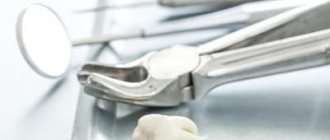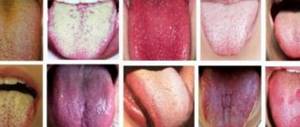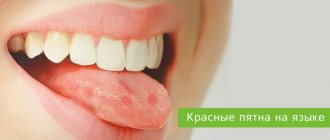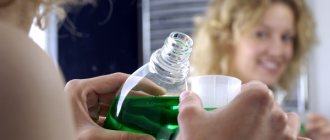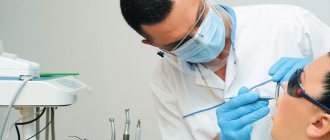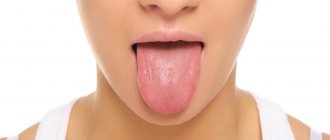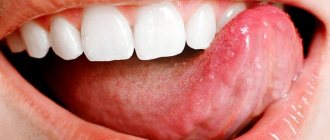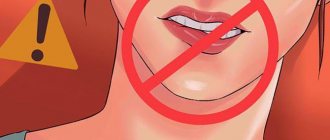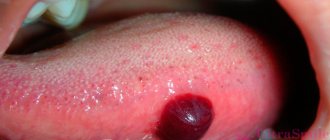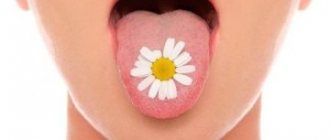When red bumps appear on the tongue, at the tip or closer to the throat, you need to find out what this phenomenon is. Such rashes often bother not only adults, but also children. And since they arise for a wide variety of reasons , it is necessary to figure out whether pimples pose a danger and choose the optimal method of treatment.
Classification of pimples
There are many types of pimples on the tongue. They are classified according to four characteristics: color, location, size and pain.
Color
Growths that do not differ in color from the tongue and are painless are warts or condylomas.
Natural, red-pink.- When red or bloody pimples , such as in the photo, their cause may be a burn, herpes, or allergic reactions.
- Red bumps that turn black are associated with mechanical damage or injury. The black color appears due to microhemorrhage.
Location
- On the tip of the tongue. Often this place is subject to injury and various damage, which can cause inflammation. First, a small bump appears on the end of the tongue, then a painful red or black pimple.
- On the side. In most cases, pimples are localized in this place, as a result of stomatitis, as well as benign neoplasms.
- At the larynx. Red pimples on the tongue closer to the throat often turn out to be benign formations: condylomas, warts.
- Under the tongue. Lumps and bumps in this place (near the frenulum) in both adults and children indicate inflammatory processes: tonsillitis, sore throat, pharyngitis.
The size of the formations can be large, medium or small.
Presence of pain
Pimples resulting from injuries, burns, inflammatory and infectious lesions of the oral cavity and larynx. Pain manifests itself when touching the tubercles; it hurts a person to speak or swallow.
Painful sensations.- There is no pain. In most cases, painlessness is characteristic of warts and condylomas. Benign neoplasms often affect the root of the tongue; you can see how it looks with pimples in the photo.
Prevention measures
To avoid acne on the tongue, you must follow these rules:
- wash your hands with antibacterial soap after walking, eating, and using the restroom;
- carry out hygienic treatment of the oral cavity using toothpaste and a brush at least 2 times a day;
- limit the consumption of foods that irritate the mucous membranes;
- get rid of bad habits;
- observe drinking regime;
- eat rationally and balanced.
If, even with all preventive measures, the tongue continues to become inflamed, you need to visit a dentist. Self-prescription of drugs complicates diagnosis when visiting a doctor, delays and complicates treatment, and can lead to unpleasant consequences.
Pimples on the tongue can appear in a variety of places - on the side, at the root, on the frenulum. If your tongue is severely inflamed, you need to contact your dentist so that he can prescribe proper treatment. Before your appointment, you can use home remedies. If the pimple hurts a lot, you need to use gels with an anesthetic. By following preventative measures, the chances of reoccurrence of the disease are significantly reduced.
Causes of pimples on the tongue
The main causes of rashes:
- Traumatic injuries, burns. It is not uncommon for the tip or side surface of the tongue to be damaged by cutlery, excessively hot food, or one’s own teeth.
- Weakened immunity. When pimples appear on the tongue closer to the throat, at its base or near the frenulum, this may indicate reduced immunity. A variety of pimples and bumps are localized here: condylomas and warts, candidal bumps.
- Development of benign and malignant tumors.
- Poor nutrition, bad habits. If you violate the rules of nutrition, excessive consumption of spicy, hot, rough foods, an irritating and traumatic effect on the mucous membrane occurs, which provokes the appearance of pimples. Excessive smoking and alcoholic libations also cause diseases of the mucous membranes in adults.
- The causes of lumps at the end and root of the tongue may be allergic. Allergic disease manifests itself not only on the skin, but also on mucous membranes.
Large bumps located close to the pharynx make it difficult to swallow food and can lead to breathing blockage.
- If pimples appear on the tongue closer to the larynx, they could be caused by various diseases of a chronic, viral and infectious nature.
- Neglect of hygiene rules. Eating unwashed foods and irregular oral hygiene not only in children, but also in adults, causes irritation of the mucous membrane and, as a result, the appearance of inflamed pimples.
Complications after illness
Even common colds and flu lead to similar complications if:
- The person has poor immunity.
- There are metabolic disorders.
- Systemic diseases of internal organs of bacterial origin were diagnosed.
- Measures to treat influenza or ARVI were not taken in a timely manner.
In some cases, the formation in the form of a bubble is an inflamed lymph node. In such a situation, antiviral or antibacterial therapy is required.
Red bumps on the tongue closer to the throat - what are they?
In most cases, bumps at the base of the tongue, pimples on the side, growths on the tip of the tongue are manifestations of the following diseases:
- Diseases of the mucous membrane of an inflammatory nature (glossitis) are accompanied by the formation of painful red rashes on the mucous membrane, in severe form - abscesses, phlegmons.
- Metabolic disorders, vitamin deficiency. Such conditions are characterized by redness and enlargement of the taste buds, which often become inflamed and acquire a red-white color.
- Herpes, characterized by the appearance of painful red pimples and blisters.
If red bumps or nodules appear on the base of the tongue, this may be a symptom of pyogenic granuloma. The formations consist of blood vessels and are localized in the wounded area. Pathology occurs due to injuries and damage to the mucous membrane. When touching the formations, a person feels a sharp pain.
- Digestive disorders (malabsorption). Pimples on the root, all over the surface of the tongue, are one of the symptoms of this pathology.
- Candidiasis (thrush). A disease that often affects newborns. The child's tongue becomes covered with red bumps and a cheesy coating forms. The baby behaves restlessly, cries, and has difficulty swallowing; these symptoms are caused by itchy red-white pimples and dry mouth.
- HPV – human papillomavirus. Formations are localized in any area of the tongue: at the tip, root, side. The bumps on the tongue closer to the larynx cause particular discomfort, as they interfere with swallowing and create the sensation of a foreign object in the mouth.
- Allergic diseases. The rashes do not hurt, but they interfere with swallowing and speaking.
- Diseases common to children: chickenpox, measles.
Diagnosis
Most often, to establish an accurate diagnosis, it is enough for the attending physician to conduct a visual examination of the oral cavity and tongue, as well as clarify the patient’s symptoms.
If the rash does not go away for a long time, there is a need for additional examination:
- General laboratory blood test. The results will help determine the general condition of the body. In the presence of infection or tumor, the erythrocyte sedimentation rate increases and the number of leukocytes increases.
- blood test to detect herpes infection. With its help, the presence of antibodies to the herpes virus in the body is clarified.
- Scraping from the surface of the tongue. The resulting material is checked for the presence of bacterial flora and candida infection. This procedure is painless for the patient. A special spatula or spatula is used for scraping.
Based on the examination results, the doctor prescribes the necessary course of treatment.
Treatment of pimples on the tongue
Carrying out an examination of the mucous membrane of the tip, side, and root of the tongue, the doctor examines the red pimples and growths. Based on laboratory tests, examination and medical history, the specialist makes a diagnosis, finds out why the disease appeared, and determines the therapeutic direction. The classic method of treatment is medication:
. Effective drugs for local action: Bioparox, Fuzafyungin. As well as medications for systemic treatment: Amoxicillin, Cefadroxil.
Antibiotics are used to destroy bacteriological pathogens- To prevent the rashes from becoming inflamed, anti-inflammatory drugs are prescribed: Stomatidin, Ingalipt, Lugol.
- Antiseptic agents accelerate wound healing: Chlorhexidine (it is necessary to apply lotions and rinses).
- Dysbacteriosis, which can cause rashes on the mucous membranes, is treated with probiotics: Bifidumbacterin, Acipol, Linex, Bifiform.
- If pimples appear on a baby's tongue, they are often caused by fungal infections; thrush is treated with antifungal drugs . It is worth doing daily rubbing of the tongue, cheeks and lips with a broad-spectrum Candide solution. After just 1–2 days, less plaque forms, and after a week, the signs of the disease completely disappear.
- Allergic reactions are eliminated with the help of antihistamines: Fenistil, Cetrin, Erius.
Oncology
It is no secret that these types of formations have specific symptoms. With malignant tumors, a bubble appears in the oral cavity that is prone to growth.
Other associated manifestations:
- the mucous skirt darkens, which is noticeable during a visual examination and collection of material for research;
- the tumor rapidly increases in size, grows and affects the tissue of the lymph nodes;
- a person loses weight, his performance decreases, and the skin acquires a peculiar, earthy tint.
Oncology manifests itself late; in the early stages it occurs without severe symptoms, which is its main danger.
Pimples appeared on the tongue: treatment at home
Having determined the nature of the rash, the doctor can prescribe a comprehensive treatment of the disease (drug and herbal treatment) or non-drug treatment at home. Pimples on the root, tip, and near the frenulum of the tongue can be removed using folk remedies.
Herbal medicine
Herbal decoctions and infusions effectively remove pimples both on the tip and at the base of the tongue. The most effective rinses are chamomile, St. John's wort, and calendula. Herbal decoctions are especially effective when the rashes are inflamed.
Method for preparing the decoction: pour a teaspoon of herbs into a glass of boiling water, leave for about 15 minutes, and cool. You need to rinse your mouth 2-4 times a day.
Infusions and decoctions can be taken orally, this will help alleviate the symptoms of the disease, relieve inflammation, and help stabilize metabolic processes.
Compresses and lotions
If the formations are inflamed, pain and inflammation can be relieved by applying a cotton swab moistened with a herbal decoction of chamomile and calendula to the affected surface.
You can numb the surface of the tongue using therapeutic and prophylactic toothpaste, which is applied for 2 minutes. The paste relieves pain, has a calming, anti-edematous and anti-inflammatory effect.
Rinsing with antiseptic solutions
They help treat inflammation of the mucous membrane, eliminate tubercles on the tongue both at the very beginning and closer to the throat. In the fight against the disease, the use of Chlorophyllipt and Chlorhexidine is common. The preparations can be used as rinses and are effective for irrigating the oral cavity. Procedures are carried out several times a day.
Syphilis
Classified as a venereal disease of bacterial origin. The bacterium infects the lymph nodes, leading to the appearance of hard chancre.
A dense formation appears on its own; other signs may not bother you at all. After a short period of time it disappears, and then the chancre appears again.
Syphilis is dangerous because it leads to the death of the patient if not treated up-to-date.
A course of antibiotic therapy, which is carried out under the supervision of a doctor, will help get rid of the signs of the disease.
It is believed that the formation appears on the genitals, but in the case of oral contact, the chancre can also appear in the oral cavity.
Food and medicine
Some foods and medications cause a bubble to appear under the tongue. What are the possible reasons:
- Aggressive substances thin the oral mucosa.
- Rough food injures and damages sensitive membranes.
Alcohol, nicotine, and aggressive substances cause serious damage to the mucous membrane and can lead to the formation of cysts and other problems. Long-term, systematic smoking is regarded as one of the causes of cancer.
What to do if there are any?
If any strange formations appear on the tongue, the most reasonable solution would be to show them to the doctor. If there is a suspicion that the symptoms are associated with throat diseases, you need to contact an otolaryngologist - ENT, and in other cases you should consult a dentist or therapist. The doctor will be able to adequately assess the situation and take the necessary actions to make the correct diagnosis:
- Conduct a blood test.
- Scrap the tongue and conduct a microscopic or bacteriological examination.
- Take tissue for histological examination.
Only after establishing the correct diagnosis will a specialist be able to select a full-fledged treatment, if necessary. You shouldn’t smear the tumors on your tongue with anything on your own, much less try to get rid of them mechanically.
ethnoscience
For inflammation and swelling of the tubercles, the following home remedies will help:
A decoction or infusion of sage, which is used for daily rinsing.- Honey and juice in equal proportions are used to treat bumps and ulcers.
- Clove and coconut cosmetic oil for treating formations.
- Aloe juice diluted with a small amount of water is used for rinsing.
- Saline solution at the rate of 10 g of salt per 1 liter of water - use for rinsing the mouth.
Before using components, you need to ensure their portability.
Ranula
This is a benign, cystic formation that occurs for several reasons. Often a cyst is a consequence of a gland being blocked by saliva.
Associated symptoms:
- the formation does not cause pain or serious discomfort;
- at the initial stage it does not interfere with eating, it increases in size slowly;
- there are no accompanying symptoms: body temperature is stable, no intoxication is observed;
- with a cyst, a person pays attention to increased salivation, which is often disturbing when a bubble appears under the tongue.
